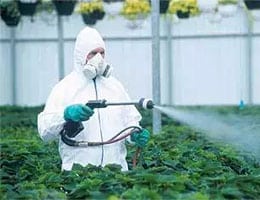 A fungicide is a product with the ability to eliminate fungi . The term, in fact, comes from the Latin word fungus , which translates precisely as "fungus" .
A fungicide is a product with the ability to eliminate fungi . The term, in fact, comes from the Latin word fungus , which translates precisely as "fungus" .
To understand what a fungicide is, therefore, we must first know that a fungus is a living being . It is a heterotrophic organism , which cannot generate organic matter from inorganic substances. Therefore, like animals, it needs to feed on other living beings. In the case of fungi, they are parasites whose reproduction is carried out through spores.
Many fungi are harmful to humans , animals and/or plants. To combat them, there are fungicides. These substances, which have a certain degree of toxicity, can be applied through impregnation, spraying, spraying or other techniques.
Fungicides are frequently used in agriculture to protect crops . When fungicides are applied to leaves, flowers, fruits or seeds, for example, blight , rust or molds, among many other fungi, can be prevented or eliminated. A commonly used fungicide is Bordeaux broth , which combines hydrated lime and copper sulfate.
If the fungicide is applied before the arrival of the spores, with the aim of preventing their germination, it is called a protective fungicide . On the other hand, when the product aims to kill the fungi that have already made the plant sick, it is a systemic fungicide or eradicator .
Beyond the benefits of fungicides, we cannot fail to mention that their excessive use is harmful to the organism affected by fungi, since it can suffer poisoning.
Fungicides are frequently used in plantations and gardens, and in fact many people consider them essential for the correct development of their plants. From the moment of transporting and storing the seeds, these products are used to ensure that no fungus negatively affects them. However, the dangers associated with them can be very serious.
 Since there are many different chemicals within the fungicide group, each designed to combat a particular type of disease, the dangers of each also vary. It is important to read the warning signs on the packages, which indicate the risks and precautions for use.
Since there are many different chemicals within the fungicide group, each designed to combat a particular type of disease, the dangers of each also vary. It is important to read the warning signs on the packages, which indicate the risks and precautions for use.
First of all we must point out the toxicity of the fungicide and its negative consequences on the skin, eyes and lungs of human beings. In its composition we usually find chemicals that can cause contact dermatitis, changes in life, chronic skin disease and pulmonary edema, among other adverse effects, some of them fatal.
On the other hand, there are the adverse effects that the fungicide can cause in nature itself. Chlorothalonil, for example, is toxic to animals. Rain that spreads it beyond its application area can contaminate groundwater and cause further damage. Both individuals who live in contaminated water and those who drink it can suffer harm. The fungicide can also reach beyond the desired limits due to the action of a strong wind; In this sense, one of the manufacturers' warnings is to avoid using it with winds exceeding 160 km/h.
Another danger of the fungicide is the resistance that fungi can develop to its action. We must not forget that these individuals evolve and are capable of becoming immune to the products created to eliminate them. This form of defense is more possible when using fungicides that attack only part of the fungus; and these are precisely the most common, since they are the least harmful to the environment.
